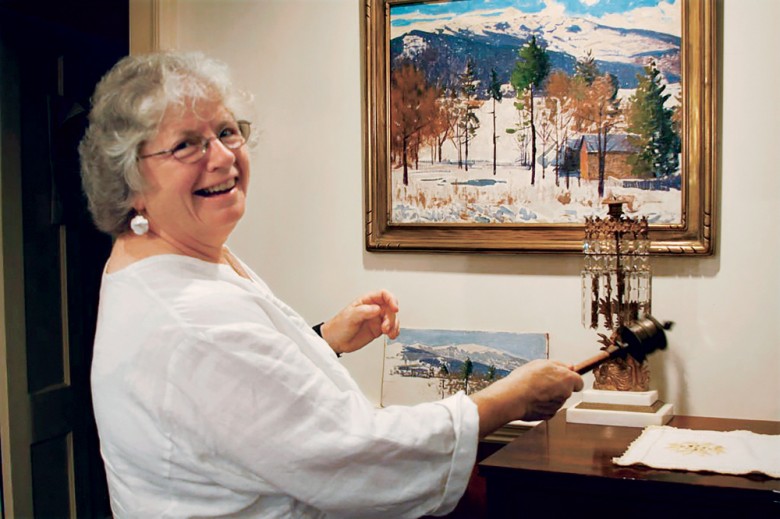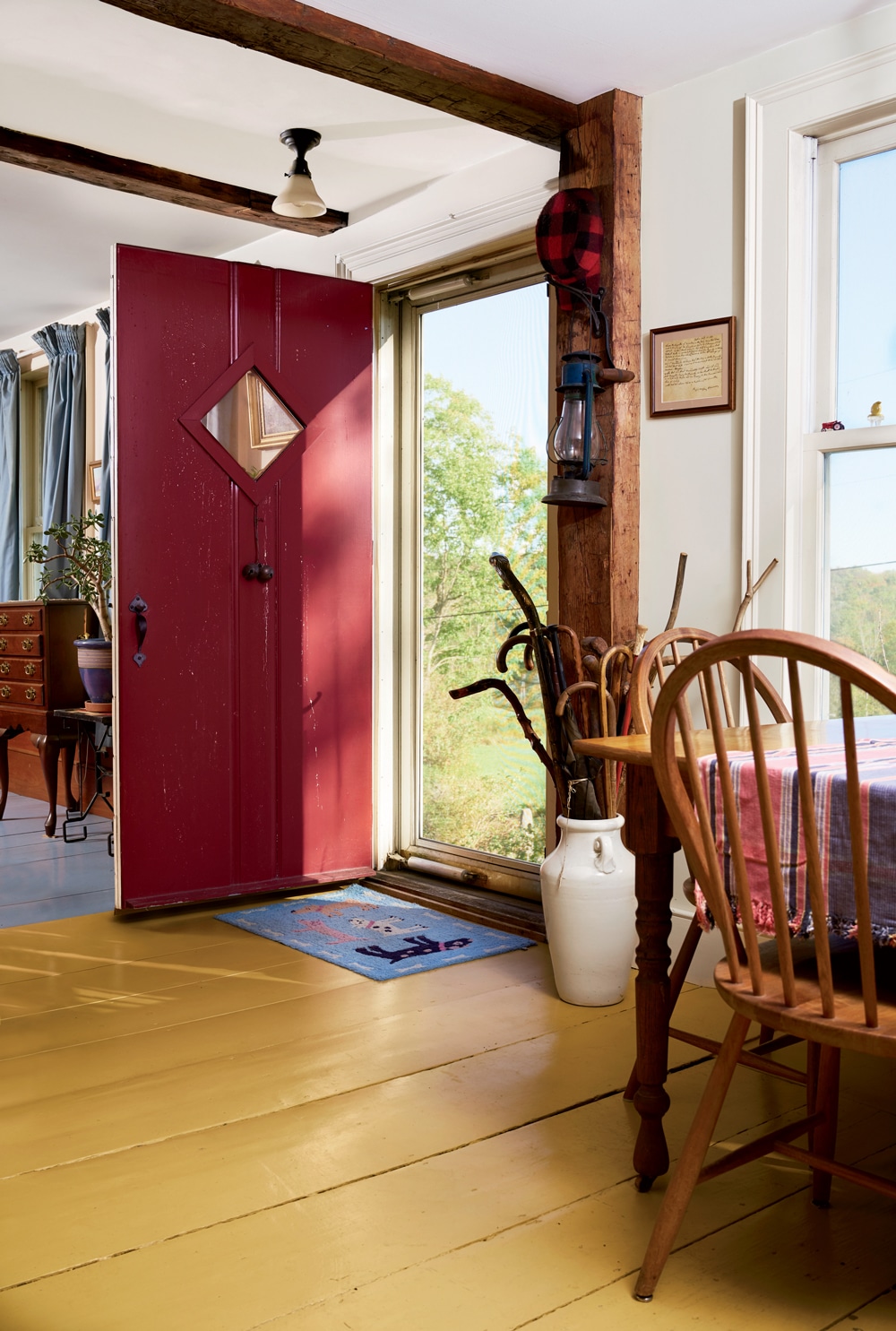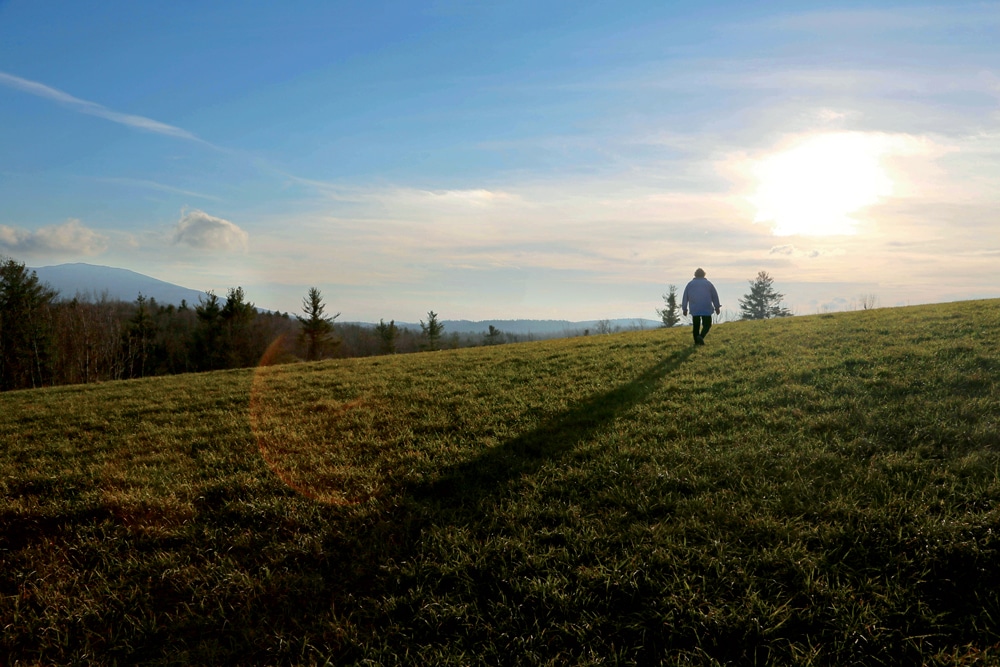In Memory of Edie Clark | Leaving Mary’s Farm
In memory of Yankee’s Edie Clark, we look back on our 2018 tribute after she said good-bye to the historic homestead where she found “the best, most rewarding kind of love.”

The Harrisville, New Hampshire, home that Edie Clark bought in 1997 and immortalized in Yankee as “Mary’s Farm.”
Photo Credit : Mark FlemingSummer 2024 update from Yankee editor Mel Allen:
Six years ago Yankee readers learned that a series of small strokes had forced Edie Clark to end her long-running “Mary’s Farm” column, and the response was as though a beloved family member had been taken from them. The letters and cards came flooding in, most of them carrying the same message: Your column was always the first thing I looked for.
Since then, letters for Edie have continued to flow to us at Yankee, and also to the nursing care facility where she lived until she passed away on July 17, 2024, at the age of 75. In her final years, Edie was unable to write, and even reading was difficult, but she kept that special essence that shone through in her writing: a love for friends who filled her life with happiness, and for the natural world she glimpsed from an outdoor patio where hummingbirds hovered.
I know Edie’s passing will deeply affect all who knew her, just as I know that her timeless columns and stories will endure into the future. — Mel Allen, editor
______________________
“It might have been the beauty of this land and its dramatic sky that brought me here, but the house, its history, its voices, the thought of the many feet that have touched its floors, this is what is so meaningful to me now. I’m only here to make it better, to make it last.”
On the first Saturday of this past autumn, Edie Clark came home. A van from the nursing home and rehabilitation facility where she had been recuperating for weeks brought her back on a sun-splashed, blue-sky day, with cars lining the narrow country road as far as the eye could see. It was just before noon, and Edie, in a wheelchair, rolled carefully down the ramp, and family and friends were smiling at her, holding out their arms. And Edie smiled back, and everyone was happy to see that.
Only five years earlier, Edie had thrown a late-summer gala here to celebrate the 250th birthday of this homestead, which Benjamin Mason built in 1762 to shelter his family and raise his livestock. The party had been a joyous occasion, marred only by a thunderstorm that sent everyone scattering but which gave Edie, as always, fodder for her column: “In so many ways, we had summoned Ben Mason into our present, into our 21st-century reality. Maybe he was answering back—maybe throwing a lightning bolt down into the trees to give us the fireworks we lacked—maybe doing some handstands up in heaven.”
For the next few hours, the house and its yard filled with a steady tide of well-wishers. A table set up by a tall shade tree held Edie’s books, which spanned 35 years of her stories about New England places and people and, most memorable of all, her columns. In the latter, she wrote about her life in two houses: one a few miles from here, a place readers knew as the Garden at Chesham Depot, and now this breathtakingly lovely homestead, Mary’s Farm, named for Mary Walker, who had lived here for many years.
In the dining room, the table filled with platters, which was fitting because nobody ever left Edie’s house with an empty belly. She sat in her chair on the lawn, looking out to the broad meadow and the stone walls and the mountain. Visitors gathered around her, sharing small talk and memories, and a few children romped in the fields. Her neighbor Anne came by, and seeing her face you knew she was also losing something precious. When the sun softened and a breeze came through, Edie asked to go inside, to see the kitchen where she had sat for so many hours facing the meadow and the mountain, writing of the moments that make up a country life: “If you could look out my front window, you would see a broad, humped hay field. Beyond it is a stretch of forest, mostly tall oak trees and some pine. And then rising above both is the mountain, Mount Monadnock, a long stretch of rock much wider than it is high, its rocky peak exposed like the blade of an old knife.”

Photo Credit : Mark Fleming
We all knew that Edie had been falling, that ordinary things had become more difficult for her. Her legs and back pained her, and she’d been hoping for surgery to bring relief. For several months her neighbor Joan had visited often to tidy up, to shop for necessities, to keep Edie going. We thought Edie was battling another flare-up of the Lyme disease that had laid her low many times in the past. We knew she had blood pressure issues, too, that could cause steady legs to wobble. What we did not know was that, in fact, it was stealthy strokes that had caused her to fall. She would call friends, afraid, abashed to be asking for help, and they always responded, getting her back on her feet, into a chair or bed, and they would entreat her to go to the hospital. She always said she’d be OK. But maybe she knew that wasn’t so—much as her dogs always seemed to know, she’d once written, when things would not be OK. Maybe she sensed that if she went to the hospital, she would not return.

Photo Credit : Ewa Buttolph
“I never thought Mary’s Farm would become mine, and to be here is like the best, most rewarding kind of love.”
Before Edie moved to Mary’s Farm, she had written about her gardens and the seasons and neighbors and small-town rituals while living in a house across the street from an old railroad depot in Chesham. She had bought the house with her second husband, Paul Bolton, a master builder, almost as a declaration of faith in their future: He had spent three years fighting cancer and was then in remission. But just a few months after they moved in, the cancer took Paul at age 39. She grieved deeply, finding relief only when she went on the road to search out the little-known people and places whose stories she told.
Edie had arrived at Yankee in 1978; I came a year after. We often walked the country roads that run by these offices. It was 1990, a year after Paul’s death, when I suggested she write a column about country life. As she later described it, “I didn’t want to pass myself off as an expert gardener, so I hoped my readers would accept me simply as a lover of the miracles of the earth and a teller of stories.” With each column, her followers grew. Many times I heard people say the first page they turned to was Edie’s.

Photo Credit : Mark Fleming
When Edie left Chesham for Mary’s Farm, her readers followed the bumps along the way: frozen pipes, snowdrifts so deep the plows broke trying to free her road, snapping turtles laying eggs in the garden, the trials and heartbreak of loving and losing a dog. And they also shared in the burst of beauty that Edie found in every season. Who could ever see frost on a window the same way again after reading this passage: “I would lie there, still snug in bed, and watch the light of the sun bring the night’s frost painting alive. I thought of this window as my winter garden, where blooms came faster and more dramatically than any flower ever could.”

Photo Credit : Mark Fleming
Edie’s columns, each about 650 words in length, revealed a life in miniature. Readers understood how deeply one can live alone, especially when one paid attention to life. She once wrote, “I find that writing the next essay is my best day.” I think that was because each time she sat down to write, it affirmed that her farm was “my sanctuary from a world that sometimes changes too fast for me.”
I know that if Edie could, she would also write about this day, and what she saw and felt when the van returned in the afternoon, the light fading a bit across the meadow. Those who had remained gathered around her, pressing tightly, cameras clicking. And for one final moment, Edie smiled back.

Photo Credit : Lori Pedrick
As I write this, Mary’s Farm does not yet have a new owner. The family is hoping to find a buyer soon—someone to drink in its views, to tend its buildings and gardens, and ultimately to become part of its long history. As for Edie, her voice is strong and steady, and the other day she said she yearned to write again. There is always uncertainty with such sudden and radical change, but of one thing I am sure: Whenever people pass by this house and this land in years to come, they will say, “Oh yes, Mary’s Farm—the place where Edie Clark wrote.”
To watch Yankee’s 2015 video tour of Mary’s Farm and hear Edie Clark talk about her life as a writer, go to newengland.com/marys-farm-video.
Mel Allen
Mel Allen is the fifth editor of Yankee Magazine since its beginning in 1935. His first byline in Yankee appeared in 1977 and he joined the staff in 1979 as a senior editor. Eventually he became executive editor and in the summer of 2006 became editor. During his career he has edited and written for every section of the magazine, including home, food, and travel, while his pursuit of long form story telling has always been vital to his mission as well. He has raced a sled dog team, crawled into the dens of black bears, fished with the legendary Ted Williams, profiled astronaut Alan Shephard, and stood beneath a battleship before it was launched. He also once helped author Stephen King round up his pigs for market, but that story is for another day. Mel taught fourth grade in Maine for three years and believes that his education as a writer began when he had to hold the attention of 29 children through months of Maine winters. He learned you had to grab their attention and hold it. After 12 years teaching magazine writing at the University of Massachusetts-Amherst, he now teaches in the MFA creative nonfiction program at Bay Path University in Longmeadow, Massachusetts. Like all editors, his greatest joy is finding new talent and bringing their work to light.
More by Mel Allen

